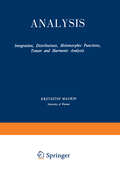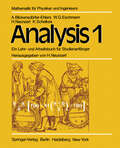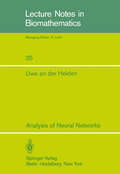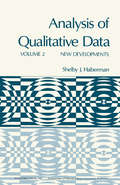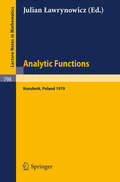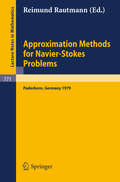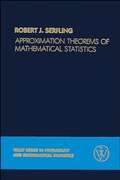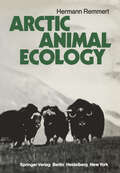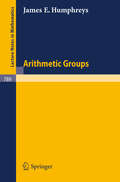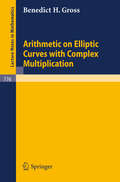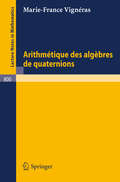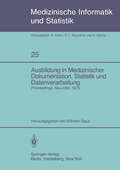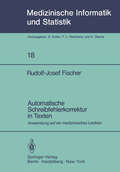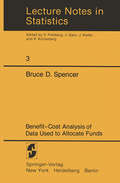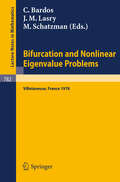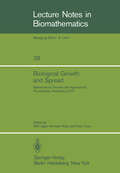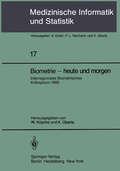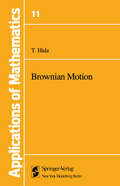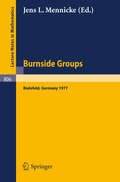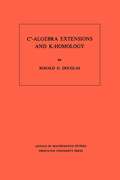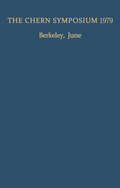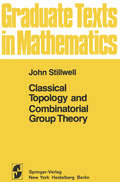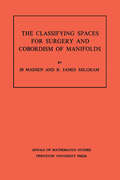- Table View
- List View
Analysis: Part II Integration, Distributions, Holomorphic Functions, Tensor and Harmonic Analysis (Analysis #2)
by Krzysztof MaurinThe extraordinarily rapid advances made in mathematics since World War II have resulted in analysis becoming an enormous organism spread ing in all directions. Gone for good surely are the days of the great French "courses of analysis" which embodied the whole of the "ana lytical" knowledge of the times in three volumes-as the classical work of Camille Jordan. Perhaps that is why present-day textbooks of anal ysis are disproportionately modest relative to the present state of the art. More: they have "retreated" to the state before Jordan and Goursat. In recent years the scene has been changing rapidly: Jean Dieudon ne is offering us his monumentel Elements d'Analyse (10 volumes) written in the spirit of the great French Course d'Analyse. To the best of my knowledge, the present book is the only one of its size: starting from scratch-from rational numbers, to be precise-it goes on to the theory of distributions, direct integrals, analysis on com plex manifolds, Kahler manifolds, the theory of sheaves and vector bun dles, etc. My objective has been to show the young reader the beauty and wealth of the unsual world of modern mathematical analysis and to show that it has its roots in the great mathematics of the 19th century and mathematical physics. I do know that the young mind eagerly drinks in beautiful and difficult things, rejoicing in the fact that the world is great and teeming with adventure.
Analysis 1: Ein Lehr- und Arbeitsbuch für Studienanfänger (Mathematik für Physiker und Ingenieure)
by A. Blickensdörfer-Ehlers W.G. Eschmann H Neunzert K. SchelkesAnalysis of Neural Networks (Lecture Notes in Biomathematics #35)
by U. an HeidenThe purpose of this work is a unified and general treatment of activity in neural networks from a mathematical pOint of view. Possible applications of the theory presented are indica ted throughout the text. However, they are not explored in de tail for two reasons : first, the universal character of n- ral activity in nearly all animals requires some type of a general approach~ secondly, the mathematical perspicuity would suffer if too many experimental details and empirical peculiarities were interspersed among the mathematical investigation. A guide to many applications is supplied by the references concerning a variety of specific issues. Of course the theory does not aim at covering all individual problems. Moreover there are other approaches to neural network theory (see e.g. Poggio-Torre, 1978) based on the different lev els at which the nervous system may be viewed. The theory is a deterministic one reflecting the average be havior of neurons or neuron pools. In this respect the essay is written in the spirit of the work of Cowan, Feldman, and Wilson (see sect. 2.2). The networks are described by systems of nonlinear integral equations. Therefore the paper can also be read as a course in nonlinear system theory. The interpretation of the elements as neurons is not a necessary one. However, for vividness the mathematical results are often expressed in neurophysiological terms, such as excitation, inhibition, membrane potentials, and impulse frequencies. The nonlinearities are essential constituents of the theory.
Analytic Functions. Kozubnik 1979: Proceedings of a Conference Held in Kozubnik, Poland, April 19-25, 1979 (Lecture Notes in Mathematics #798)
by J. LawrynowiczWith contributions by numerous Experts
Approximation Methods for Navier-Stokes Problems: Proceedings of the Symposium Held by the International Union of Theoretical and Applied Mechanics (IUTAM) at the University of Paderborn, Germany, September 9-15, 1979 (Lecture Notes in Mathematics #771)
by R. RautmannApproximation Theorems of Mathematical Statistics (Wiley Series in Probability and Statistics #162)
by Robert J. SerflingApproximation Theorems of Mathematical Statistics This convenient paperback edition makes a seminal text in statistics accessible to a new generation of students and practitioners. Approximation Theorems of Mathematical Statistics covers a broad range of limit theorems useful in mathematical statistics, along with methods of proof and techniques of application. The manipulation of "probability" theorems to obtain "statistical" theorems is emphasized. Besides a knowledge of these basic statistical theorems, this lucid introduction to the subject imparts an appreciation of the instrumental role of probability theory. The book makes accessible to students and practicing professionals in statistics, general mathematics, operations research, and engineering the essentials of: * The tools and foundations that are basic to asymptotic theory in statistics * The asymptotics of statistics computed from a sample, including transformations of vectors of more basic statistics, with emphasis on asymptotic distribution theory and strong convergence * Important special classes of statistics, such as maximum likelihood estimates and other asymptotic efficient procedures; W. Hoeffding's U-statistics and R. von Mises's "differentiable statistical functions" * Statistics obtained as solutions of equations ("M-estimates"), linear functions of order statistics ("L-statistics"), and rank statistics ("R-statistics") * Use of influence curves * Approaches toward asymptotic relative efficiency of statistical test procedures
Arctic Animal Ecology
by Hermann RemmertA large number of comprehensive publications has been devoted to the Antarctic, to its plant and animal life. It is therefore relatively easy to familiarize oneself with the current state of Antarctic research. Nothing comparable is available for the Arctic. The heterogeneity and richness of the northern polar regions seem to have discouraged any attempt at a synthethic approach. This book has evolved from an attempt to summarize the results of 15 years of ecological and physiological research work in the Arctic - mostly on Spitsbergen. The necessity of comparing our results and the ecological conditions of Spitsbergen with other arctic regions grew into a full-sized book on arctic animal ecology. It is not meant as an exhaustive survey ofthe relevant literature. Instead I have tried to show how closely the various fields of research are interwoven, how many questions can be solved if only notice is taken of fellow scientists and their results, and how much arctic animals have in common. This book would not have been possible without the helpfulness of many colleagues. Above all I should like to mention Professor Ronning and Professor Solem of Trondheim University (Norway), Professor Arnthor Gardasson of Reykjavik University (Iceland), Dr. NettIeship, Dr. Oliver and Dr. Ryder of Canada and Professor West of Fairbanks University (Alaska, USA).
Arithmetic on Elliptic Curves with Complex Multiplication (Lecture Notes in Mathematics #776)
by B.H. GrossAusbildung in Medizinischer Dokumentation, Statistik und Datenverarbeitung: Symposium anläßlich des zehnjährigen Bestehens der Schule für Medizinische Dokumentationsassistenten der Universität Ulm, Neu-Ulm, 10. Juli 1979 (Medizinische Informatik, Biometrie und Epidemiologie #25)
by W. GausAutomatische Schreibfehlerkorrektur in Texten: Anwendung auf ein medizinisches Lexikon (Medizinische Informatik, Biometrie und Epidemiologie #18)
by R.-J. FischerBenefit-Cost Analysis of Data Used to Allocate Funds (Lecture Notes in Statistics #3)
by Bruce SpencerThis monograph treats the question of determining how much to spend for the collection and analysis of public data. This difficult problem for government statisticians and policy-makers is likely to become even more pressing in the near future. The approach taken here is to estimate and compare the benefits and costs of alternative data programs. Since data are used in many ways, the benefits are hard to measure. The strategy I have adopted focuses on use of data to determine fund allocations, particularly in the General Revenue Sharing program. General Revenue Sharing is one of the largest allocation programs in the United States. That errors in population counts and other data cause sizable errors in allocation has been much publicized. Here we analyze whether the accuracy of the 1970 census of population and other data used by General Revenue Sharing should be improved. Of course it is too late to change the 1970 census program, but the method and techniques of analysis will apply to future data programs. In partic ular, benefit-cost analyses such as this are necessary for informed decisions about whether the expense of statistical programs is justi fied or not. For example, although a law authorizing a mid-decade census was enacted in 1976, there exists great doubt whether funds will be provided so a census can take place in 1985. (The President's Budget for 1981 allows no money for the mid-decade census, despite the Census Bureau's request for $1. 9 million for planning purposes.
Bifurcation and Nonlinear Eigenvalue Problems: Proceedings, Universite de Paris XIII, Villetaneuse, France, October 2-4, 1978 (Lecture Notes in Mathematics #782)
by C. Bardos J. M. Lasry M. SchatzmanBildhaftigkeit und Organisation: Untersuchungen zu einer differenzierten Organisationshyothese (Reihe 1: Grundlagenforschung und Grundlegende Methodik)
by W. WippichWissenschaftliche Forschungsberichte,Reihe I,Abt.C,Band 80
Biological Growth and Spread: Mathematical Theories and Applications, Proceedings of a Conference Held at Heidelberg, July 16 – 21, 1979 (Lecture Notes in Biomathematics #38)
by W. Jäger H. Rost P. TautuThese Proceedings have been assembled from papers presented at the Conference on Models of Biological Growth and Spread, held at the German Cancer Research Centre Heidelberg and at the Institute of Applied Mathematics of the University of Heidelberg, July 16-21, 1979. The main theme of the conference was the mathematical representation of biolog ical populations with an underlying spatial structure. An important feature of such populations is that they and/or their individual com ponents may interact with each other. Such interactions may be due to external disturbances, internal regulatory factors or a combination of both. Many biological phenomena and processes including embryogenesis, cell growth, chemotaxis, cell adhesion, carcinogenesis, and the spread of an epidemic or of an advantageous gene can be studied in this con text. Thus, problems of particular importance in medicine (human and veterinary), agriculture, ecology, etc. may be taken into consideration and a deeper insight gained by utilizing (more) realistic mathematical models. Since the intrinsic biological mechanisms may differ considerably from each other, a great variety of mathematical approaches, theories and techniques is required. The aims of the conference were (i) To provide an overview of the most important biological aspects. (ii) To survey and analyse possible stochastic and deterministic approaches. (iii) To encourage new research by bringing together mathematicians interested in problems of a biological nature and scientists actively engaged in developing mathematical models in biology.
Biometrie — heute und morgen: Interregionales Biometrisches Kolloquium 1980 der Deutschen Region und Region Österreich — Schweiz der Internationalen Biometrischen Gesellschaft München, 17.–20. März 1980 (Medizinische Informatik, Biometrie und Epidemiologie #17)
by W. Köpcke K. ÜberlaBrownian Motion (Stochastic Modelling and Applied Probability #11)
by T. HidaFollowing the publication of the Japanese edition of this book, several inter esting developments took place in the area. The author wanted to describe some of these, as well as to offer suggestions concerning future problems which he hoped would stimulate readers working in this field. For these reasons, Chapter 8 was added. Apart from the additional chapter and a few minor changes made by the author, this translation closely follows the text of the original Japanese edition. We would like to thank Professor J. L. Doob for his helpful comments on the English edition. T. Hida T. P. Speed v Preface The physical phenomenon described by Robert Brown was the complex and erratic motion of grains of pollen suspended in a liquid. In the many years which have passed since this description, Brownian motion has become an object of study in pure as well as applied mathematics. Even now many of its important properties are being discovered, and doubtless new and useful aspects remain to be discovered. We are getting a more and more intimate understanding of Brownian motion.
Burnside Groups: Proceedings of a Workshop Held at the University of Bielefeld, Germany, June-July 1977 (Lecture Notes in Mathematics #806)
by J. L. MennickeC*-Algebra Extensions and K-Homology. (AM-95), Volume 95 (PDF)
by Ronald G. DouglasRecent developments in diverse areas of mathematics suggest the study of a certain class of extensions of C*-algebras. Here, Ronald Douglas uses methods from homological algebra to study this collection of extensions. He first shows that equivalence classes of the extensions of the compact metrizable space X form an abelian group Ext (X). Second, he shows that the correspondence X ⃗ Ext (X) defines a homotopy invariant covariant functor which can then be used to define a generalized homology theory. Establishing the periodicity of order two, the author shows, following Atiyah, that a concrete realization of K-homology is obtained.
Chancen für das Elektrofahrzeug?: Teil I: Batterien für elektrische Straßenfahrzeuge: Teil II: Elektrizität für den Straßenverkehr? (Energiepolitische Schriftenreihe #6)
by Adolf Neckel Christoph Fabjan Kurt SeldenBereits im Energieplan, den das Bundesministerium für Handel, Gewerbe und Industrie im März 1975 veröffentlicht hat, wurde bei den Möglichkeiten für die Substitution von Energieträgern auf die Elektrotraktion hingewiesen. So heißt es dort im Punkt 18. 2. 3. 3 u. a. : "Im Straßenverkehr in Ballungszentren empfiehlt sich ein erweiterter Ein satz der Elektrotraktion, dem vorläufig durch das ungünstig hohe Lei stungsgewicht der Batterien gewisse Grenzen, vor allem hinsichtlich der Reichweite der Fahrzeuge, gesetzt sind. Verbesserungen werden hier durch die Entwicklung der Zink-Chlorbatterien und später durch den Ein satz von Akkumulatoren mit nicht-wässrigen Elektrolyten erhofft. Nach dem derzeitigen Stand ist nicht anzunehmen, daß der Verbrennungsmotor in den Städten vollkommen substituiert werden kann. Lediglich ein Teil wird auf Elektrotraktion umgestellt werden können . . . . Die Auswirkungen eines erweiterten Einsatzes der Elektrotraktion auf den Ausbau der Er zeugungs-und insbesondere der Verteilungsanlagen für elektrische Energie sind noch eingehend zu prüfen. " Diese Feststellungen stützten sich vornehmlich auf die in Fachpublikatio nen enthaltenen Angaben über Stand und Aussichten der Batterieentwicklung. Diese Angaben waren jedoch teilweise widersprüchlich und in vieler Hin sicht mangelhaft. So wurde es als ein Gebot empfunden, dem Mangel abzuhel fen und die Einschätzung der Chancen der Elektrotraktion auf eine sicherere Basis zu stellen. In dankenswerter Weise hat zunächst das Bundesministerium für Wissenschaft und Forschung durch die Einsetzung eines Projektteams "Elektrochemische Energiespeicherung" eine Bestandsaufnahme nationaler und internationaler Forschungen und Entwicklungen von elektrochemischen Ener giespeichern durchgeführt, deren Ergebnisse von diesem Ressort im Jahr 1976 veröffentlicht wurden.
The Chern Symposium 1979: Proceedings of the International Symposium on Differential Geometry in honor of S.-S. Chern, held in Berkeley, California, June 1979
by M. F. Atiyah R. Bott E. Calabi M. Green P. Griffiths F. Hirzebruch N. H. Kuiper J. Moser L. Nirenberg R. Osserman Wen-Tsün Wu Ning Yang Chen Shing-Tung YanThis volume attests to the vitality of differential geometry as it probes deeper into its internal structure and explores ever widening connections with other subjects in mathematics and physics. To most of us Professor S. S. Chern is modern differential geometry, and we, his students, are grateful to him for leading us to this fertile landscape. The aims of the symposium were to review recent developments in geometry and to expose and explore new areas of research. It was our way of honoring Professor Chern upon the occasion of his official retirement as Professor of Mathematics at the University of California. This book is a record of the scientific events of the symposium and reflects Professor Chern's wide interest and influence. The conference also reflected Professor Chern's personality. It was a serious occasion, active yet relaxed, mixed with gentleness and good humor. We wish him good health, a long life, happiness, and a continuation of his extraordinarily deep and original contributions to mathematics. I. M. Singer Contents Real and Complex Geometry in Four Dimensions M. F. ATIYAH. . . . . . . . . . . . . Equivariant Morse Theory and the Yang-Mills Equation on Riemann Surfaces RAOUL BaTT .. 11 Isometric Families of Kahler Structures EUGENIO CALABI. . 23 Two Applications of Algebraic Geometry to Entire Holomorphic Mappings MARK GREEN AND PHILLIP GRIFFITHS. • . . . • . . 41 The Canonical Map for Certain Hilbert Modular Surfaces F. HIRZEBRUCH . . . . . • . . . . . . . . . 75 Tight Embeddings and Maps. Submanifolds of Geometrical Class Three in EN NICOLAAS H. KUIPER .
Classical Topology and Combinatorial Group Theory (Graduate Texts in Mathematics #72)
by John StillwellIn recent years, many students have been introduced to topology in high school mathematics. Having met the Mobius band, the seven bridges of Konigsberg, Euler's polyhedron formula, and knots, the student is led to expect that these picturesque ideas will come to full flower in university topology courses. What a disappointment "undergraduate topology" proves to be! In most institutions it is either a service course for analysts, on abstract spaces, or else an introduction to homological algebra in which the only geometric activity is the completion of commutative diagrams. Pictures are kept to a minimum, and at the end the student still does not understand the simplest topological facts, such as the reason why knots exist. In my opinion, a well-balanced introduction to topology should stress its intuitive geometric aspect, while admitting the legitimate interest that analysts and algebraists have in the subject. At any rate, this is the aim of the present book. In support of this view, I have followed the historical develop ment where practicable, since it clearly shows the influence of geometric thought at all stages. This is not to claim that topology received its main impetus from geometric recrea. ions like the seven bridges; rather, it resulted from the visualization of problems from other parts of mathematics complex analysis (Riemann), mechanics (poincare), and group theory (Oehn). It is these connections to other parts of mathematics which make topology an important as well as a beautiful subject.
Classifying Spaces for Surgery and Corbordism of Manifolds. (AM-92), Volume 92 (PDF)
by Ib Madsen R. James MilgramBeginning with a general discussion of bordism, Professors Madsen and Milgram present the homotopy theory of the surgery classifying spaces and the classifying spaces for the various required bundle theories. The next part covers more recent work on the maps between these spaces and the properties of the PL and Top characteristic classes, and includes integrality theorems for topological and PL manifolds. Later chapters treat the integral cohomology of BPL and Btop. The authors conclude with a discussion of the PL and topological cobordism rings and a construction of the torsion-free generators.
